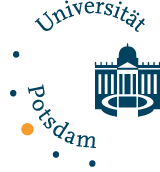SFB 1287/C1: Shift of Borders in Syntactic Variability: A Training Approach
Project Program
Is syntactic variability within a language just small scale version of variation between languages? The leading idea of project C01 is that this is not necessarily the case: the grammar of a language defines a space of potential constructions, from which different varieties select different subsets for actual use. Such a view is reminiscent of Coseriu’s 1952 distinction between system (the construction space) and norm (the set of constructions actually employed). A recent version of such a model of language and grammar was proposed by our Mercator-fellow Sjef Barbiers 2005, 2009 in his analysis of word order in Dutch verb clusters (a proposal he modified in Barbiers et al. 2018).
For investigating this hypothesis, the project employs the method of repeated exposure to grammatical constructions. The project postulates that repeated exposure effects in language production (syntactic priming) and language perception (satiation) are confined to structures within the space of possible constructions. Hence, for constructions not used in a certain variety, one should see “positive repeated exposure effects” (such as increase acceptability/increased frequency of use) only if such structures belong to the space of potential constructions.
Repeated Exposure in Productions
On the basis of the results of Kaschak (2005), Kaschak & Glenberg (2004) and our own previous research (Fanselow, Kliegl & Schlesewsky 2005), we postulated that there should be long-lasting production effects of exposure to structures that are licensed by the grammar of a language yet not used in a certain variety. The project modified training technique developed in Fanselow et al. 2005 in the interest of increased methodological rigour, and also set out with an investigation of long wh-movement, but we also investigated order in verb clusters. So far, training effects for grammatically licensed structures not in use in the variety in question could not be detected. We are investigating what might be responsible for the contrast between the results of Fanselow et al (2005) and our current findings.
Repeated Exposure in Perception
A crucial issue in the interpretation of repeated exposure effects is whether these only have a gradual impact on the linguistic norm/system, or can eliminate grammatical differences between constructions altogether. We look at this issue with an extension of the standard satiation paradigm, by exposing participants to 120 target items distributed over 6 experimental blocks. The construction investigated was multiple questions with and without crossing movement. We observed a moderate increase in the acceptability of target items with intermediate acceptability between the 1st and the 2nd block, while there were no further training effects in later blocks. A comparison of the repeated exposure effect for crossing movement with the development of judgments for the standardized filler items developed by Featherston and colleagues strongly suggests that the satiation effect is not construction-specific, but is a function of the degree of acceptability: items of any kind that start out in the upper yet not perfect segment of the acceptability scale receive higher ratings because of repeated exposure, while less acceptable and close to perfect items are not affected.
The Variability of Long Movement
Following Fanselow et al (2005), we chose long wh-movement as the primary construction for our training experiment. While the relative likelihood of producing long wh-movement has been mapped for Germany by Fanselow & Weskott (2010), there is no direct comparison of the relative acceptability of construction in various regions. A pilot study revealed that the acceptability difference for this construction between Bavaria and Brandenburg smaller than suspected (1 point on a 7-point scale). A more systematic survey comparing Bavaria, Brandenburg, Eastfalia, the Ruhr area and the Rostock area is in the process of being completed.
The Variability of the Copy Construction
While the variability concerning long movement has a clear regional pattern (e.g., Fanselow & Weskott 2010) the wh-copy construction does not seem to be confined in this way. In particular, anecdotal evidence on different treatments of complex wh-items does not support any interpretation in terms of regional dialects. In collaboration with our Mercator fellow Sjef Barbiers, we are currently investigating the grammar of complexity of the copy construction in various regional dialects of Dutch and German.
Ongoing change of grammar boundaries between generations of speakers
There is some anecdotal evidence that some constructions showing regional variation in German are becoming more acceptable, raising the question whether the boundaries of grammars used by speakers of different generations differ. In collaboration with project A02, we ran an ongoing change study using a new apparent time paradigm testing differences in how younger and older speakers of Brandenburg German perceive long movement, word order in infinitives, and control sentences with varying degrees of interpretability.
Learning biases against impossible constructions
If some constructions lie outside the total construction space, then we expect to see learning biases impeding acquisition of those constructions. In collaboration with Natalie Boll-Avetisyan from project C03, we are running an artificial language learning study testing learning biases in orders of modal verbs in German and English.
